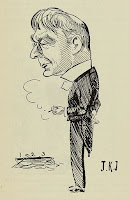The New Utopia Anew
Written in 1891, The New Utopia is one of the few short stories Jerome Klapka Jerome wrote and it is warm and witty, with acute political and psychological insight. It all starts after an extremely interesting, and rather luxurious, evening the narrator had with his friends at the "National Socialist Club". "We had had an excellent dinner: the pheasant, stuffed with
truffles, was a poem; and when I say that the ’49 Chateau Lafitte
was worth the price we had to pay for it, I do not see what more I
can add in its favour. After dinner, and over the cigars (I must say they do know how
to stock good cigars at the National Socialist Club), we had a very
instructive discussion about the coming equality of man and the
nationalisation of capital."
The narrator, while at home, recalls this last conversation with his friends and their dream of deconstructing the present world of inequality and unfairness only to create a new bright world of equality and fairness for all. Then, he sleeps on it.
It is refreshing to read a story made up with so few and simple elements. For this simplicity, it reads rather simplistic. It is not. This short story is significant as it is one of the first (if not the very first) of its kind and, thus, considered early prophetic – it grasps the exact true nature of socialism and its totalitarian dimensions. Being a great influence to classical works of dystopian science fiction, as Yevyeni Zamyatin's We and possibly Ray Bradbury's Fahrenheit 451, The New Utopia is also significant for another reason - it comes from an underprivileged writer who knew all about the hardships of poverty firsthand.
Jerome K. Jerome was born in a middle-class affluent family but he had no easy life ahead. He had to earn a living at the age of 14, after his father's colliery failed and shortly after, both of his parents died. First as a clerk, then as a touring actor who found himself sleeping rough on the streets in London, Jerome, later, tried to become a journalist, a school teacher, a packer and a solicitor's clerk. He had some success as a writer in 1885 and wide recognition in 1888 with his most famous novel Three Men in a Boat. Until then, and after that, he had to sustain himself through constant work and writing.
Yet, Jerome did not support the power of the majority nor its demand for socialism. His penetrating satire aims with zest at the egalitarian fallacies of such a society. In his story, the narrator wakes up in the 29th century and finds himself in display in the Museum of Curiosities. He has been there since 11 February 1900 when he was found [ from the account given by the landlady of the house, it would appear that he had already, when discovered, been asleep for over ten years (she having forgotten to call him) ] and taken to the Museum. The museum attendant offers to give him the grand tour of the town as The Great Social Revolution happened in 1899 and things have changed since then.
While on tour, the narrator walks past plenty of juxtapositions of logic: there are no houses, only huge barracks-like buildings; no horses or carriages, only electric cars; no shops, bars, theatres or books – the State has decided that they are not necessary. All people are wearing the same grey clothes, they have the same haircut in black, they eat at the same time, the exact same food at the exact portions prepared by the State; marriage and family have been abolished. You can't even have a shower on your own convenience – a state servant washes you every day at the same time...
But, all's well that ends well: the narrator finally realises that he had just only been dreaming; in his own bed, for a few hours, in the 19th century. And "through the open window I hear the rush and roar of old life’s
battle. Men are fighting, striving, carving out each man his own
life with the sword of strength and will. Men are laughing, grieving, loving, doing wrong deeds, doing great deeds, — falling,
struggling, helping one another — living!"
Despite its comic sense, I didn't find it as such. There is much -alarmingly much- relevance to the present – the rise of populism, fascism and political correctness in the western world tends towards what Jerome K. Jerome depicts: a place, not yet so uniform but, unfree. After having experienced the actual effects of applied socialism in the former USSR and recently in Argentina and Venezuela, not to mention the case in China, this four-page story sets the issue anew and reads, after all, as a stark reminder, a warning if you wish, of reality.





